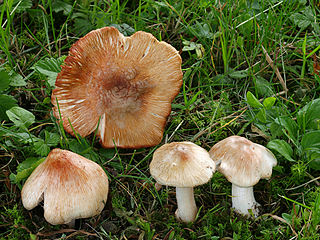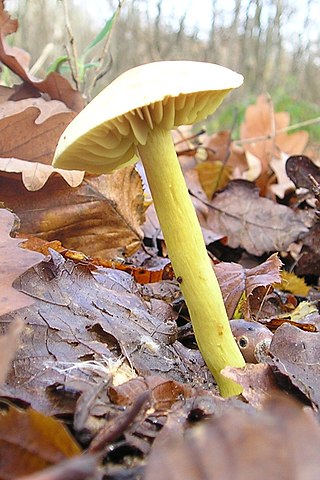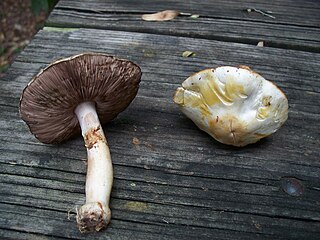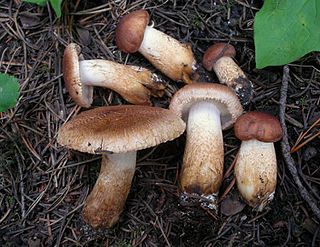Toxicity
This species was for a long time highly regarded as one of the tastier edible species (and in some guides still is), [5] and sold in European markets; medieval French knights allegedly reserved this species for themselves, leaving the lowly bovine bolete ( Suillus bovinus ) for the peasants. [6]
Concern was first raised in southwestern France. People who have been poisoned have all had three or more meals containing T. equestre within the last two weeks prior to treatment. One to four days after their last meal containing the fungus, the patients reported weakness of the muscles, sometimes accompanied by pain. This weakness progressed for another three to four days accompanied by a feeling of stiffness and darkening of the urine. Periods of nausea, sweating, reddening of the face were also registered, but there were no fevers. [7]
As yet, there have been no reported cases of poisoning in North America, [8] and there is speculation that the respective mushrooms may in fact be different species that are very similar in appearance. Molecular research shows that multiple species may have been identified as T. flavovirens on the West Coast. [9]
There are reports where patients treated for T. equestre poisoning have died, likely as a result of the poisoning. [10] The poison in this mushroom has remained unknown. The basic mechanism of poisoning is suspected to be rhabdomyolysis, damaging of the cell membrane of skeletal muscle fibres. In this disorder, the oxygen-carrying muscular protein myoglobin is released and appears in urine, resulting in symptoms such as muscle pain and brownish coloration of the urine. [11]
A 2018 research conducted in Poland with the recruitment of ten healthy volunteers, who ate 300 grams per head (about twice the normal dose) of fried T. equestre in a single meal, with no reported consequences or alterations. [12] However, a 2020 systematic review highlights several studies indicating elevated plasma creatine kinase (CK) pro-inflammatory activities, in addition to its effect on other liver function biomarkers, underlining a cause for concern and suggestions "not to harvest and consume this species". [13]

Amanita phalloides, commonly known as the death cap, is a deadly poisonous basidiomycete fungus, one of many in the genus Amanita. Widely distributed across Europe, but introduced to other parts of the world since the late twentieth century, A. phalloides forms ectomycorrhizas with various broadleaved trees. In some cases, the death cap has been introduced to new regions with the cultivation of non-native species of oak, chestnut, and pine. The large fruiting bodies (mushrooms) appear in summer and autumn; the caps are generally greenish in colour with a white stipe and gills. The cap colour is variable, including white forms, and is thus not a reliable identifier.

Edible mushrooms are the fleshy fruit bodies of several species of macrofungi. Edibility may be defined by criteria including the absence of poisonous effects on humans and desirable taste and aroma. Mushrooms that have a particularly desirable taste are described as "choice". Edible mushrooms are consumed for their nutritional and culinary value. Mushrooms, especially dried shiitake, are sources of umami flavor.

The genus Amanita contains about 600 species of agarics, including some of the most toxic known mushrooms found worldwide, as well as some well-regarded edible species. The genus is responsible for approximately 95% of fatalities resulting from mushroom poisoning, with the death cap accounting for about 50% on its own. The most potent toxin present in these mushrooms is α-Amanitin.

Mushroom poisoning is poisoning resulting from the ingestion of mushrooms that contain toxic substances. Symptoms can vary from slight gastrointestinal discomfort to death in about 10 days. Mushroom toxins are secondary metabolites produced by the fungus.

Russula is a very large genus composed of around 750 worldwide species of ectomycorrhizal mushrooms. They are typically common, fairly large, and brightly colored – making them one of the most recognizable genera among mycologists and mushroom collectors. Their distinguishing characteristics include usually brightly coloured caps, a white to dark yellow spore print, brittle, attached gills, an absence of latex, and absence of partial veil or volva tissue on the stem. Microscopically, the genus is characterised by the amyloid ornamented spores and flesh (trama) composed of spherocysts. Members of the related genus Lactarius have similar characteristics but emit a milky latex when their gills are broken. The genus was described by Christian Hendrik Persoon in 1796.

Tricholoma is a genus of fungus that contains many fairly fleshy white-spored gilled mushrooms which are found worldwide generally growing in woodlands. These are ectomycorrhizal fungi, existing in a symbiotic relationship with various species of coniferous or broad-leaved trees. The generic name derives from Ancient Greek: τριχο-, romanized: tricho-, lit. 'hair' and Ancient Greek: λῶμα, romanized: loma, lit. 'fringe, border' although only a few species have shaggy caps which fit this description.

Inocybe erubescens, also known as I. patouillardii, commonly known as the deadly fibrecap, brick-red tear mushroom or red-staining Inocybe, is a poisonous basidiomycete fungus, one of many in the genus Inocybe and one of the few known to have caused death. It is found growing in small groups on leaf litters in association with beech. All mushroom guidebooks as well as mushroom hunters advise that the entire Inocybaceae should be avoided for consumption. The fruit bodies appear in spring and summer; the bell-shaped caps are generally pale pinkish in colour with red stains, with a reddish-pink stipe and gills.

Entoloma sinuatum is a poisonous mushroom found across Europe and North America. Some guidebooks refer to it by its older scientific names of Entoloma lividum or Rhodophyllus sinuatus. The largest mushroom of the genus of pink-spored fungi known as Entoloma, it is also the type species. Appearing in late summer and autumn, fruit bodies are found in deciduous woodlands on clay or chalky soils, or nearby parklands, sometimes in the form of fairy rings. Solid in shape, they resemble members of the genus Tricholoma. The ivory to light grey-brown cap is up to 20 cm (7.9 in) across with a margin that is rolled inward. The sinuate gills are pale and often yellowish, becoming pink as the spores develop. The thick whitish stem has no ring.

Tricholoma sulphureum, also known as the stinker, sulphur knight or gas agaric, is an inedible or mildly poisonous mushroom found in woodlands in Europe. It has a distinctive bright yellow colour and an unusual smell likened to coal gas. It occurs in deciduous woodlands in Europe from spring to autumn.

Agaricus campestris is a widely eaten gilled mushroom closely related to the cultivated A. bisporus. A. campestris is commonly known as the field mushroom or, in North America, meadow mushroom.

Amanita ocreata, commonly known as the death angel, destroying angel, angel of death or more precisely western North American destroying angel, is a deadly poisonous basidiomycete fungus, one of many in the genus Amanita. The large fruiting bodies generally appear in spring; the cap may be white or ochre and often develops a brownish centre, while the stipe, ring, gill and volva are all white. A. ocreata resembles several edible species commonly consumed by humans, increasing the risk of accidental poisoning. Mature fruiting bodies can be confused with the edible A. velosa, A. lanei or Volvopluteus gloiocephalus, while immature specimens may be difficult to distinguish from edible Agaricus mushrooms or puffballs.

Tricholoma pardinum, commonly known as spotted tricholoma, tiger tricholoma, tigertop, leopard knight, or dirty trich, is a gilled mushroom widely distributed across North America, Europe, and parts of Asia. It is generally found in beech woodland in summer and autumn. Two subspecies have been described from southern Europe. First officially described by Christiaan Hendrik Persoon in 1801, T. pardinum has had a confusing taxonomic history that extends over two centuries. In 1762, German naturalist Jacob Christian Schäffer described the species Agaricus tigrinus with an illustration corresponding to what is thought to be T. pardinum, and consequently, the name Tricholoma tigrinum has been used erroneously in some European field guides.

Lepiota brunneoincarnata, the deadly dapperling, is a gilled mushroom of the genus Lepiota in the order Agaricales. Widely distributed in Europe and temperate regions of Asia as far east as China, it grows in grassy areas such as fields, parks and gardens, and is often mistaken for edible mushrooms. The mushroom has a brown scaled cap up to 4 cm wide with a pinkish brown stem and white gills. It is highly toxic, with several deaths having been recorded as it resembles the edible grey knight and fairy ring champignon.

Inocybe geophylla, commonly known as the earthy inocybe, common white inocybe or white fibercap, is a poisonous mushroom of the genus Inocybe. It is widespread and common in Europe and North America, appearing under both conifer and deciduous trees in summer and autumn. The fruiting body is a small all-white or cream mushroom with a fibrous silky umbonate cap and adnexed gills. An all-lilac variety lilacina is also common.

Agaricus abruptibulbus is a species of mushroom in the genus Agaricus. It is commonly known as the abruptly-bulbous agaricus or the flat-bulb mushroom. First described by the mycologist Charles Horton Peck, this bulbous-stemmed edible species smells slightly of anise or bitter almond, and turns yellow when bruised or cut. The mushroom is medium-sized, with a white, yellow-staining cap on a slender stipe that has a wide, flat bulb on the base.

Tricholoma terreum, commonly known as the grey knight or dirty tricholoma, is a grey-capped mushroom of the large genus Tricholoma. It is found in coniferous woodlands in Europe, and has also been encountered under introduced pine trees in Australia and New Zealand. It is regarded as edible. A 2014 article speculated that it may be poisonous, but Sitta et al. in 2016 published in the same journal a counter article demonstrating the unfounded nature of such speculation.

Tricholoma saponaceum, also known as the soap-scented toadstool, soapy tricholoma, soapy knight or soap tricholoma is an inedible mushroom found in woodlands in Europe and North America.

Tricholoma vaccinum, commonly known as the russet scaly tricholoma, the scaly knight, or the fuzztop, is a fungus of the agaric genus Tricholoma. It produces medium-sized fruit bodies (mushrooms) that have a distinctive hairy reddish-brown cap with a shaggy margin when young. The cap, which can reach a diameter of up to 6.5 cm (2.6 in) wide, breaks up into flattened scales in maturity. It has cream-buff to pinkish gills with brown spots. Its fibrous, hollow stipe is white above and reddish brown below, and measures 4 to 7.5 cm long. Although young fruit bodies have a partial veil, it does not leave a ring on the stipe.

Tricholoma ustale, commonly known as the burnt knight, is a species of mushroom in the large genus Tricholoma. It is found in Asia, Europe, and North America, though those from North America may represent one or more different species.

Tricholoma sejunctum is a mushroom that appears across much of the Northern Hemisphere and is associated with pine forests.



















